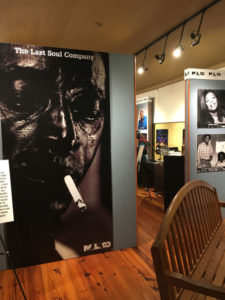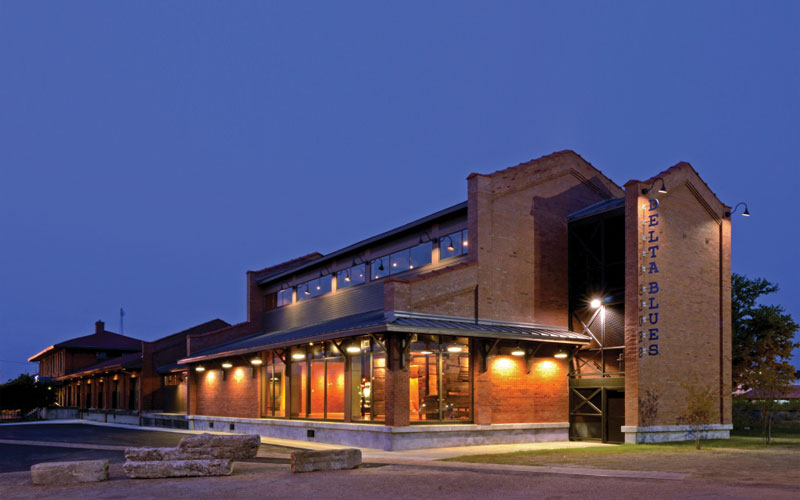By Angela Rogalski
 Along with a brand new year, January 2019 ushered in a milestone for the Delta Blues Museum in Clarksdale as they celebrated their 40th anniversary. Shelley Ritter is executive director of the museum and says recognizing the importance of the museum’s mission is vital for the preservation of the music genre’s history in the Mississippi Delta.itself for success.
Along with a brand new year, January 2019 ushered in a milestone for the Delta Blues Museum in Clarksdale as they celebrated their 40th anniversary. Shelley Ritter is executive director of the museum and says recognizing the importance of the museum’s mission is vital for the preservation of the music genre’s history in the Mississippi Delta.itself for success.
“We’re the world’s first museum devoted entirely to blues. The Delta Blues Museum was formed January 30, 1979. Sid Graves, who was the Carnegie Public Library director at the time, along with the library’s Board of Trustees, created the Delta Blues Museum in the Myrtle Hall Branch of the library. Then in 1981, the Delta Blues Museum moved from Myrtle Hall to 114 Delta Avenue, inside the main library branch.”
After that move, Ritter says the museum found its current home some eighteen years later in 1999 at #1 Blues Alley.
Ritter says that for many years the Delta Blues Museum’s Arts and Education Program has continued the great musical tradition born in the Mississippi Delta: the Delta blues.
“The Arts and Education program teaches students to play music and keeps the history of the Delta blues alive,” says Ritter Students are taught to play the blues on the instrument or instruments of their choice. Instruments—drums, guitars, and keyboards—are provided by the museum for use in the classroom and authorized performances. However, we encourage students to purchase their own instruments. The students’ progress from learning the basics of playing music to working together as a band.”
Students are taught to play the blues on the instrument or instruments of their choice. Instruments—drums, guitars, and keyboards—are provided by the museum for use in the classroom and authorized performances. However, we encourage students to purchase their own instruments. The students’ progress from learning the basics of playing music to working together as a band.”
And in 2000, the Delta Blues Museum Band was nationally recognized.
“Under the Direction of Mr. Johnnie Billington, the Delta Blues Museum Band traveled to the White House to perform for President Bill Clinton,” says Ritter. “President Clinton later met privately with each person in the museum delegation.”
In 2001, Muddy Waters’ Cabin returned to Clarksdale where it had originated from on the Stovall Plantation, and was installed in the Delta Blues Museum after being disassembled in 1996 for display at various Hard Rock Cafés.
 Ritter was hired in 2003, which was also the year Congress declared the “Year of the Blues.” The Delta Blues Museum was part of the celebration committee and also when Governor Ronnie Musgrove created the Mississippi Blues Commission.
Ritter was hired in 2003, which was also the year Congress declared the “Year of the Blues.” The Delta Blues Museum was part of the celebration committee and also when Governor Ronnie Musgrove created the Mississippi Blues Commission.
Ritter says the Board wanted to expand the Delta Blues Museum, so in 2012 they added 7300 sq. ft. to the depot, and named it the “Muddy Waters’ Wing,” receiving the “Delta Best” award in recognition of this outstanding contribution in tourism.
“In 2013, the Delta Blues Museum was one of five museums in the nation to receive a National Medal for Museum and Library Services, our nation’s highest honor for museums,” says Ritter. “The award was presented in the East Wing of the White House by First Lady Michelle Obama.”
Also in 2013, the Delta Blues Museum received a Mississippi Blues Trail Marker and the Museum additionally received international acclaim by being added to the Best in Heritage Excellence Club, in Dubrovnik, Croatia. So, 2013 was definitely a landmark year for the Museum.
“Then in 2014, we were one of twelve youth programs recognized with a National Arts & Humanities Youth Program Award,” Ritter adds. “I was able to take five of our students back to the White House. Of the twelve recipients, we were one of two selected to perform in the East Wing of the White House for First Lady Michelle Obama. It was really great.”
In 2018 The Museum received the largest grant award from the National Endowment for Humanities and now they’re working on the installation of the Museum’s first phase of long-awaited new exhibits.
“These will be new permanent exhibits,” she says. “We’ve finished the designs and are awaiting total funding to complete these permanent exhibits. So, we’re doing it as we can. We encourage donations to the Museum so that we can move forward with these very important exhibits.”
these permanent exhibits. So, we’re doing it as we can. We encourage donations to the Museum so that we can move forward with these very important exhibits.”
Created by Louisville, Kentucky-based Solid Light, Inc., the new exhibits explore Clarksdale’s New World District, juke joints, Alan Lomax’s first recording of Muddy Waters, early blues radio programs and the last great migration of Delta artists northward, and how all those factors impacted the music the world continues to enjoy today.
Current exhibits that are on display at the Delta Blues Museum include: Celebrating 50 Years of Malaco, Muddy Waters’ cabin, and a new exhibit from award-winning journalist, Panny Mayfield, who has been photographing blues and gospel musicians at festivals, clubs, churches, and juke joints for decades.
“We have a portion of our new permanent exhibits up in the Muddy Waters Wing,” She says. “And we have an exhibit of Panny Mayfield’s photographs, ‘Live From the Mississippi Delta.’”
 Ritter says that the 40th celebration for the museum featured cake and refreshments, live music from the award-winning Delta Blues Museum student band and musical guests from around the Delta. People were able to come into the Muddy Waters Wing and see the direction the Museum is headed with its new permanent exhibits.
Ritter says that the 40th celebration for the museum featured cake and refreshments, live music from the award-winning Delta Blues Museum student band and musical guests from around the Delta. People were able to come into the Muddy Waters Wing and see the direction the Museum is headed with its new permanent exhibits.
“Last year, we received visitors from nearly every state in the U.S. and from thirty-four countries around the world,” Ritter adds. “With our new exhibits and new media, we hope to attract even more blues fans in our 40th year, to continue our mission to share the history and heritage of this important American art form with generations to come. We’re not about any single artist or entity, we want to honor the men and women who created this music that basically shaped all music and culture the way that we know it today around the world. And with the new permanent exhibits, we hope to tell an even deeper story than we do now.”

